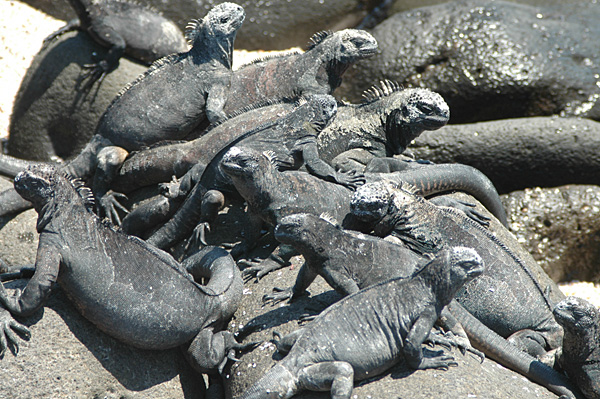9 Iguanas
“The Amblyrhynchus, a remarkable genus of lizards, is confined to this archipelago: there are two species, resembling each other in general form, one being terrestrial and the other aquatic. This latter species (A. cristatus) was first characterised by Mr. Bell, who well foresaw, from its short, broad head, and strong claws of equal length, that its habits of life would turn out very peculiar, and different from those of its nearest ally, the Iguana. It is extremely common on all the islands throughout the group, and lives exclusively on the rocky sea-beaches, being never found, at least I never saw one, even ten yards in-shore. It is a hideous-looking creature, of a dirty black colour, stupid, and sluggish in its movements. The usual length of a full-grown one is about a yard, but there are some even four feet long; a large one weighed twenty pounds: on the island of Albemarle they seem to grow to a greater size than elsewhere. Their tails are flattened sideways, and all four feet partially webbed. They are occasionally seen some hundred yards from the shore, swimming about; and Captain Collnett, in his Voyage, says, “They go to sea in herds a-fishing, and sun themselves on the rocks; and may be called alligators in miniature.” It must not, however, be supposed that they live on fish. When in the water this lizard swims with perfect ease and quickness, by a serpentine movement of its body and flattened tail—the legs being motionless and closely collapsed on its sides. A seaman on board sank one, with a heavy weight attached to it, thinking thus to kill it directly; but when, an hour afterwards, he drew up the line, it was quite active. Their limbs and strong claws are admirably adapted for crawling over the rugged and fissured masses of lava, which everywhere form the coast. In such situations, a group of six or seven of these hideous reptiles may oftentimes be seen on the black rocks, a few feet above the surf, basking in the sun with outstretched legs.
I opened the stomachs of several, and found them largely distended with minced sea-weed (Ulvæ), which grows in thin foliaceous expansions of a bright green or a dull red colour. I do not recollect having observed this sea-weed in any quantity on the tidal rocks; and I have reason to believe it grows at the bottom of the sea, at some little distance from the coast. If such be the case, the object of these animals occasionally going out to sea is explained. The stomach contained nothing but the sea-weed. The nature of this lizard’s food, as well as the structure of its tail and feet, and the fact of its having been seen voluntarily swimming out at sea, absolutely prove its aquatic habits.”

Complete the following activity to check your knowledge.
Media Attributions
- Galapagos marine iguanas © Clark Anderson/Aquaimages, via Wikimedia is licensed under a CC BY-SA (Attribution ShareAlike) license

